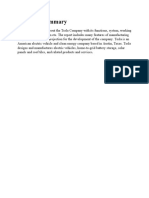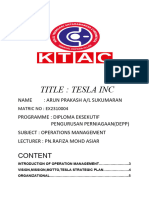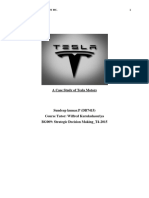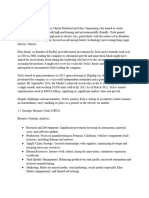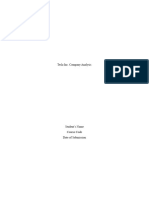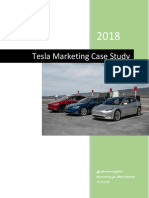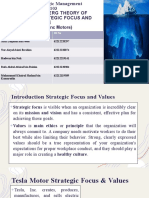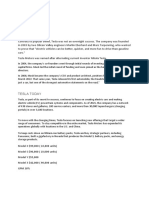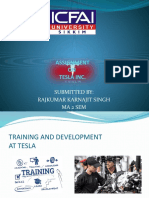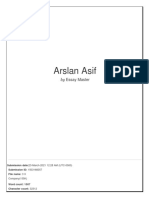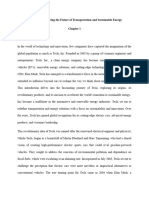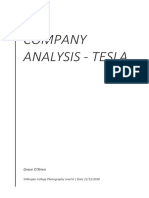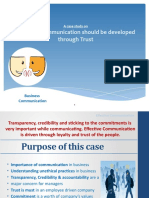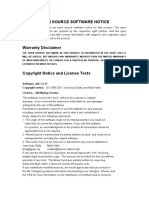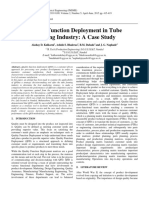Introduction of TESLATesla
Inc. is an American electric vehicle and clean energy company based in Palo Alto,
California. Tesla's current products include electric cars, battery energystorage from
home to grid-scale, solar panels and solar roof tiles, as well as other related products
and services. In 2020, Tesla had the highest sales in the plug-in and battery electric
passenger car segments, capturing 16% of the plug-in market (which includes plug-in
hybrids) and 23% of the battery-electric (purely electric) market. Through its
subsidiary Tesla Energy, the company develops and is a major installer of solar
photovoltaic energy generation systems in the United States. Tesla Energy is also one
of the largest global suppliers of battery energy storage systems, with 3 GWh of
battery storage supplied in 2020.Founded in July 2003 by Martin Eberhard and Marc
Tarpenning as Tesla Motors, the company's name is a tribute to inventor and
electrical engineer Nikola Tesla. Elon Musk, who contributed most of the funding in
the early days, has served as CEO since 2008. According to Musk, the purpose of
Tesla is to help expedite the move to sustainable transport and energy, obtained
through electric vehicles and solar power. Tesla began production of their first car
model, the Roadster, in 2009. This was followed by the Model S sedan in 2012, the
Model X SUV in 2015, the higher volume Model 3 sedan in 2017, and the Model Y
crossover in 2020. The Model 3 is the world's all-time best-selling plug-in electric car,
with more than 800,000 delivered through December 2020. Tesla's global vehicle
saleswere 499,550 units in 2020, a 35.8% increase over the previous year. In 2020,
thecompany surpassed the 1 million mark of electric cars produced.
Tesla has been the subject of numerous lawsuits and controversies arising from
statements and acts of CEO Elon Musk, allegations of creative accounting, allegations
of whistleblower retaliation, alleged worker rights violations, and allegedly
unresolved and dangerous technical problems with their products.
Human Resource Management Of TESLATesla Motors Inc. is a Silicon Valley-based
company that designs, manufactures and sells electric vehicles (EVs) and electric
vehicle powertrain components. It iscurrently the only automaker building and selling
a zero-emission sports car in he Model S, which will be built in Fremont, California.
Tesla also sells its electric powertrain components to other automakers, including
Daimler and ToyotaThese two models are the most commonly use HRM models in
businesses today aside from other models that has been theorized and formulated by
some academics. Based on the definitions and explanation of each model, it can be
concluded that the soft model is more advisable to be practiced by industries within
the service sector while the manufacturing sector would be better to use the
Michigan Model of HRM for increased production.Importance and Purpose of
TeslaTesla's mission is to accelerate the world's transition to sustainable energy.
Tesla was founded in 2003 by a group of engineers who wanted to prove that people
didn't need to compromise to drive electric – that electric vehicles can be better,
quicker and more fun to drive than gasoline cars.Performance Management At
TeslaLike most organizations of Tesla's size and influence, its performance
management system is somewhat of a mystery.But if you know how to read between
the lines, there are some interesting strandsto follow. For starters, it seems that the
performance management culture has changed quite dramatically over the last few
years as the company has grown.From employee development to stack rankingBack
in 2016, when Juliana Bednarski was HR Business Partner and Louis Efronwas Head of
� Global Employee Engagement, the picture looked quite different. Ina presentation
for Talent Week, Bednarski and Efron outlined Tesla’s dynamic approach to
leveraging the best talent.They recognized the importance of engaged employees
and their impact on customer engagement. In response, they created the Tesla360
Summary. This was have embraced an entirely different approach. Details are thin,
but it seems that they've gone back to using a traditional annual review to determine
promotions, demotions and firings.That's a stark switch up from their previous
engagement-focused approach aimedat helping employees reach the top of the self-
actualization pyramid.Changing priorities, changing processIn an email statement
submitted to Fortune, a Tesla spokesperson confirmed that performance reviews
happen annually and employees meet with managers to discuss their achievements
over the past 12 months. As a result, top performers are rewarded with
compensation, equity awards or promotions. And we saw whathappens to the low
performers. Not much to go on there. But it's clear that Tesla is driving hard to
deliver what former employee, Spencer Gore (now CEO of Impossible Aerospace)
describes as “industry-defining product on a limited budg
internal factors that empower the company to compete against other firms, and
toensure profitability, especially in the long term. For example, the company’s strong
brand can support strategic expansion in the global market. In this company analysis
case of Tesla, the following strengths shape the capabilities of the business as a
competitive player in the automotive industry:1. Highly innovative processes2. Strong
brand3. Strong control on production processesTesla, Inc. is known for its high rate of
innovation, especially in introducing the world’s first fully electric sports car. This
internal strategic factor is a strength that empowers the company to develop
competitive and profitable products. Alsoconsidered in this SWOT analysis, the Tesla
brand is a strong symbol of innovation and renewable energy solutions, in line with
CEO Elon Musk’s business goals. Such a strong brand optimizes the company’s ability
to attract andretain new customers. The internal factor of strong control on
production processes is based on vertical integration, as well as the centralization
and hierarchy in Tesla’s organizational structure. For example, the company
manufactures automobiles and many of their components. This factor is a strength
that minimizes issues linked to the involvement of third parties. Overall, this aspect
of the SWOT analysis of Tesla points to innovation and brand image as major
strengths of the company.Tesla’s Weaknesses (Internal Strategic Factors)The internal
factors that limit organizational performance are identified in this aspect of the
SWOT Analysis. These internal factors are weaknesses that can reduce Tesla’s
competitiveness and business growth. In the context of this business analysis,
weaknesses are issues that the company must overcome through strategies, reforms,
and initiatives. Despite its strong brand as a manufacturer of electric vehicles, Tesla,
Inc.’s performance and potential future growth suffer from the following major
weaknesses:
1. Limited market presence
2. Limited supply chain
3. High prices




